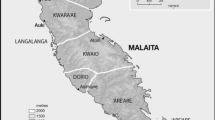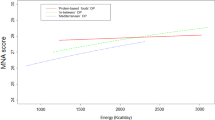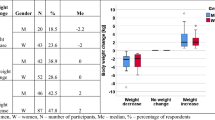Abstract
Objectives: To (a) examine participation rate as a function of municipality, age group and living status; and (b) investigate the main reasons for exclusion and declining as stated by the women themselves.
Design: Analysis of participation rate and content analysis of statements given in phone calls explaining exclusion or declination from a project in which 24 h recalls and food-diaries were used.
Subjects: Self-managing Swedish women (n=505) were systematically selected from a stratified random sample covering single living and cohabiting women aged 64–68, 74–78 and 84–88 y living in three municipalities.
Results: No significant differences were found among included and declining women when municipalities and living status was analysed, but significantly more women in the oldest group were excluded (P>0.01). Among those in their 80s living at home, the usual reasons for exclusion were illness, disability or dementia, and many lived in institutions for old people. The four most used explanations to decline participation were ‘lack of time’, ‘tired, fragile, sick or having bad memory’, ‘not willing to participate in scientific studies’ and ‘too old and nothing to contribute’.
Conclusions: The participation rate was, compared with other food surveys in the older generation, fairly good, especially among those in their 80s. However, the most active and the very ill and disabled did not participate.
Sponsorship: The Swedish Council for Social Research, the Swedish Council for Forestry and Agricultural Research, the Swedish Foundation for Health and Care Sciences and Allergy Research and Uppsala University.
This is a preview of subscription content, access via your institution
Access options
Subscribe to this journal
Receive 12 print issues and online access
$259.00 per year
only $21.58 per issue
Buy this article
- Purchase on Springer Link
- Instant access to full article PDF
Prices may be subject to local taxes which are calculated during checkout
Similar content being viewed by others
References
Andersen NL, Fagt S, Groth MV, Hartkopp HB, Mller A, Ovesen L, Warming DL . 1996 Danish dietary habits 1995 (English summary). National Food Authority, Report no. 235 Copenhagen: Quickly Tryk A/S
Becker W . 1994 Dietary habits and nutrient intake in Sweden 1989. Methods and results (English summary) Uppsala: National Food Administration
Berglund L . 1998 Dietary investigations—what are the effects of invalid selection procedures and measurement errors? Scand. J. Nutr./Näringsforskning 42: 60–62
Dirren HM . 1994 EURONUT-SENECA: a European Study of Nutrition and Health in the Elderly Nutr. Rev. 8: 38–43
Harries T, Woteki C, Briefel RR, Kleinman JC . 1989 NHANES III for older persons: nutritional content and methodological considerations Am. J. Clin. Nutr. 50: 1145–1149
Holcomb CA . 1995 Positive influence of age and education on food consumption and nutrient intakes of older women living alone J. Am. Diet. Assoc. 95: 1381–1386
Isaksson B . 1998 Methodology problems of dietary assessment in analytical studies (English summary) Scand. J. Nutr./Näringsforsk-ning 42: 50–55
Johansson L, Solvoll K, Björneboe G-E Aa, Drevon CA . 1997 Dietary habits among Norwegian men and women Scand. J. Nutr./Näringsforskning 41: 63–70
Kaye JA . 1998 Diagnostic challenges in dementia Neurology 51: S45–S52
Kleemola P, Virtanen M, Pietinen P . 1994 The 1992 dietary survey of Finnish adults Publication of the National Public Health Institute, B2/1994 Helsinki: National Public Health Institute
Larsson G, Unosson M, Ek A-C, Nilsson L, Thorslund S, Bjurulf P . 1990 Effect of dietary supplement on nutritional status and clinical outcome in 501 geriatric patients—a randomised study Clinical Nutr. 9: 179–184
Lyon P, Colquhoun A . 1999 Home, hearth and table: a centennial review of nutritional circumstances of older people living alone Aging Society 19: 53–67
Nyth AL, Gottfries CG, Blennow K, Bråne G, Wallin A . 1991 Heterogeneity of the course of Alzheimer's disease: a differentiation of subgroups Dementia 2: 18–24
Polit FD, Hungler BP . 1999 Nursing Research. Principles and Methods Philadelphia, PA: JB Lippincott
Rothenberg E, Bosaeus I, Steen B . 1993 Intake of energy, nutrients and food items in an urban elderly population Aging Clin. Exp. Res. 5: 105–116
SCB Statistics Sweden. 1999 Statistical Yearbook of Sweden Örebro: Publication Services
Sidenvall B, Nydahl M, Fjellström C . 2000 The meal as a gift. The meaning of cooking among retired women J. Applied Gerontol. 19: 405–423
Sidenvall B, Nydahl M, Fjellström C . 2001 Managing food shopping and cooking: the experiences of older Swedish women Ageing Society 21: 135–152
Steingrimsdottir L, Torgeirsdottir H, Aegisdottir S . 1991 Könnun a mataraedi Islenndinga 1990. 1. Helstu nidurstödur (in Icelandic) Reykjavik: National Nutrition Council Prentsmidjan Gutenberg hf
Stitt S, O'Connell C, Grant D . 1995 Old, poor and malnourished Nutr. Health 10: 135–154
Szebehely M . 1998 Hjälp i hemmet i nedskärningstid—hemtjänstens och anhörigas insatser för gamla kvinnor och män In Åt var och en efter behov ed. Sandqvist A-M Stockholm: Kommentus förlag
van't Hof MA, Burema J . 1996 Assessment of bias in the SENECA study Eur. J. Clin. Nutr. 50: (Suppl 2): S4–S8
van't Hof MA, Hautvast JGAJ, Schroll M, Vlachonikolis IG . 1991 Design, methods and participation Eur. J. Clin. Nutr. 45: (Suppl 3): S5–S22
Webb GP, Copeman J . 1996 The Nutrition of Older People London: Arnold and Age Concern
Wolfe WS, Olson CM, Kendall A, Frongillo EA Jr . 1996 Understanding food insecurity in the elderly: a conceptual framework J. Nutr. Educ. 28: 92–100
Wright AJA, Southon S, Bailey AL, Finglas PM . 1995 Nutrient intake and biochemical status of non-institutionalized elderly subjects in Norwich: comparison with younger adults and adolescents from the same general community Br. J. Nutr. 74: 453–475
Wylie C, Copeman J, Kirk SFL . 1999 Health and social factors affecting the food choice and nutritional intake of elderly people with restricted mobility J. Hum. Nutr. Diet. 12: 375–380
Author information
Authors and Affiliations
Corresponding author
Rights and permissions
About this article
Cite this article
Sidenvall, B., Fjellström, C., Andersson, J. et al. Reasons among older Swedish women of not participating in a food survey. Eur J Clin Nutr 56, 561–567 (2002). https://doi.org/10.1038/sj.ejcn.1601359
Received:
Revised:
Accepted:
Published:
Issue Date:
DOI: https://doi.org/10.1038/sj.ejcn.1601359
Keywords
This article is cited by
-
Who will become malnourished? A prospective study of factors associated with malnutrition in older persons living at home
The Journal of nutrition, health and aging (2009)
-
Minimal effect on energy intake by additional evening meal for frail elderly service flat residents — A pilot study
The Journal of nutrition, health and aging (2008)
-
Nutritional status, well-being and functional ability in frail elderly service flat residents
European Journal of Clinical Nutrition (2005)



